Sony PCG-NV100, PCG-NV100P User Guide

Welcome
Congratulations on your purchase of this Sony VAIO® computer, and welcome to the VAIO User Guide.
This User Guide provides detailed information on all aspects of using your new VAIO computer, from keyboard functions to preinstalled software applications.
In the left navigation window, click the topics you want to learn more about, and that information will be displayed in this main window.
 Click here to find the latest updates and supplemental information about your computer.
Click here to find the latest updates and supplemental information about your computer.
 Click here to view your computer's hardware specifications and software information.
Click here to view your computer's hardware specifications and software information.
Page 1

Using Your VAIO Computer
This section describes the following aspects of your new computer:
Using the Keyboard
Using the Touchpad
Using the Center Jog Dial Control
Using the Optical Disc Drive
Using PC Cards
Using Memory Stick Media
Using the Multipurpose Bay
Using the Floppy Disk Drive
Using Power Saving Modes
Connecting a Telephone Cable
Connecting to a Local Area Network
Connecting to a Wireless LAN
Page 2
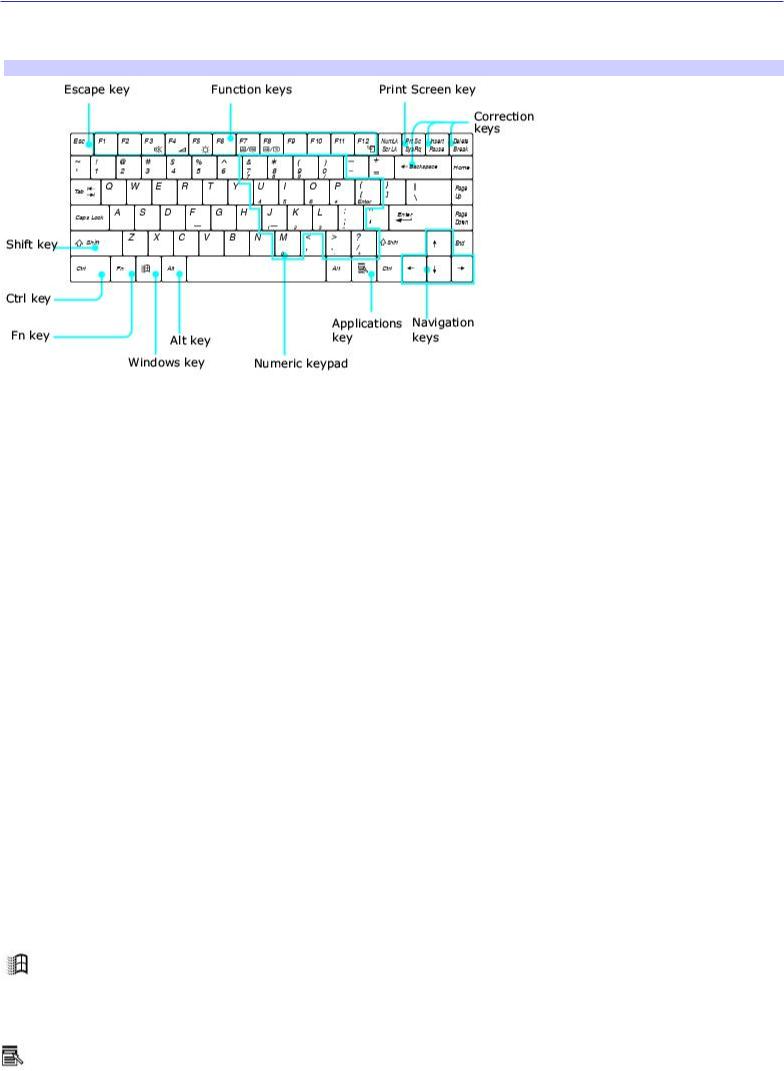
Using the Keyboard
Your computer's keyboard is very similar to that of a typewriter, but the keyboard has additional keys that perform specific computer-related tasks.
Keyboard
Key |
Description |
|
Numeric keypad |
Contains the keys found on a typical calculator. Use the numeric keypad area to type numbers or to |
|
perform mathematical calculations such as addition and subtraction. Note that you must press the Num Lock key to activate the numeric keypad. (When you do so, the Num Lock light will be on.) Press the Num Lock key again to deactivate it.
Navigation keys |
The Left/Right/Up/Down arrow keys are devoted to move the cursor on the screen, and also function |
as the Home, End, Page Up, and Page Down keys, respectively. |
|
Correction keys |
The Insert, Back Space, and Delete keys enable you to make corrections in your documents. |
Function keys The 12 function keys along the top of the keyboard are used to perform designated tasks. For example, in many applications, F1 is the Help key. The task associated with each function key may vary from one application to the next.
Escape key The Esc (Escape) key is used to cancel commands.
Print Screen key The Print Screen key takes an electronic snapshot of the screen and places it in the Windows® Clipboard. You can then paste the screen shot into a document and print it.
Operator keys
(Shift, Ctrl, Alt keys) Several keys are always used with at least one other key: Ctrl, Alt, and Shift. When held down with another key, the Ctrl (Control) and Alt (Alternate) keys offer another way to give commands. For example, in many applications, instead of choosing the Save command from a menu, you can hold down Ctrl and press S (referred to as Ctrl+S). The Shift key operates the same way as on a typewriter; it is used to produce capital letters or special symbols such as @ and $.
Windows key
|
The key with the Windows logo displays the Windows Start menu; it is the equivalent of clicking the Start |
button on the taskbar. See Combinations and functions with the Windows key for more information. |
|
Fn key |
The Fn key is used in combination with other keys to issue commands. See Combinations and functions with |
the Fn key for more information. Applications key
Page 3
The Applications key displays a shortcut menu of context-sensitive choices. Pressing this key is the equivalent
of clicking the right mouse button.
Page 4

Combinations and functions with the Windows key
Combination |
Function |
+ F1 |
Displays the VAIO Help and Support Center window. |
+ Tab |
Switches the selected button on the taskbar. |
+ D |
Displays the desktop. |
+ E |
Displays the My Computer window. |
+ F |
Displays the Search window to find a file or folder. This is the equivalent of selecting Search from the Start |
menu. |
|
 + Ctrl + F Displays the Search Results: Computers window where you can locate other computers. This is the equivalent of selecting Search and then Computers from the Start menu.
+ Ctrl + F Displays the Search Results: Computers window where you can locate other computers. This is the equivalent of selecting Search and then Computers from the Start menu.
+ M |
Minimizes all displayed windows. |
|
Shift + |
+ M Returns all minimized windows to their previous size. |
|
+ R |
Displays the Run window. This is the equivalent of selecting Run from the Start menu. |
|
Fn + |
+ Insert |
Displays the Properties window. This is the equivalent of selecting Control Panel and then System |
from the Start menu.
Page 5
Indicators
Indicator Function
Power
 Light is green when the power to the computer is turned on, flashes amber in Standby mode, and turns off when the computer is in Hibernate mode or powered off.
Light is green when the power to the computer is turned on, flashes amber in Standby mode, and turns off when the computer is in Hibernate mode or powered off.
Battery
 Indicates the status of the battery inserted in the battery bay. Memory Stick
Indicates the status of the battery inserted in the battery bay. Memory Stick
 Indicates that the Memory Stick® slot is in use. Hard disk
Indicates that the Memory Stick® slot is in use. Hard disk
 This indicator will light when data is being read from or written to the hard disk. Do not enter Standby mode or turn off the computer when this indicator is on.
This indicator will light when data is being read from or written to the hard disk. Do not enter Standby mode or turn off the computer when this indicator is on.
Page 6

Indicator lights
Light On |
Off |
Num Lock
 The number keys in the numeric keypad are active. The alphanumeric character keys in the keypad area are active.
The number keys in the numeric keypad are active. The alphanumeric character keys in the keypad area are active.
Caps Lock
The letters appear in uppercase as you type. The Shift key lowers the case of typed letters when Caps Lock is on. Letters appear in lower case as you type (unless you hold down the Shift key).
Scroll Lock
The screen scrolls differently. (Exactly how it scrolls depends on the specific application. It has no effect in many applications.) Information moves across the display normally.
Page 7
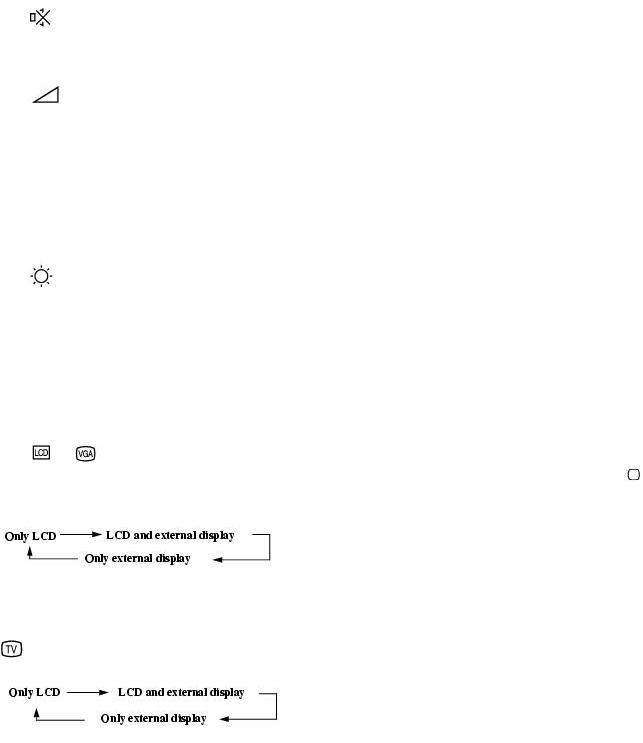
Combinations and functions with the Fn key
 If you switch user identities during a computing session, the Fn+F7 and Fn+F8 key functionality (if available on your computer) will be interrupted. To switch to an external display or monitor, see Selecting the Display Mode for more information.
If you switch user identities during a computing session, the Fn+F7 and Fn+F8 key functionality (if available on your computer) will be interrupted. To switch to an external display or monitor, see Selecting the Display Mode for more information.
Combinations/
Feature |
|
Function |
Fn+ |
(F3) |
|
Mute On/Off |
Toggles the built-in speaker off and on. |
|
Fn+ |
(F4) |
|
Speaker volume |
Adjusts the built-in speaker volume. |
|
To increase volume, press Fn+F4, then  or
or  .
.
To decrease volume, press Fn+F4, then  or
or  .
.
Fn+ |
(F5) |
|
Brightness control |
Adjusts the brightness of the LCD. |
|
To increase light intensity, press Fn+F5 and then  or
or  .
.
To decrease light intensity, press Fn+F5 and then  or
or  .
.
Fn+ |
/ |
(F7) |
|
Switch to the external monitor/LCD Toggles through the LCD, external display (connected to the |
Monitor port) and |
||
both LCD and external display. |
|
||
Select one display at a time to playback DVDs. Connect the cable before you turn on the computer, otherwise Fn + F7 will not work.
Fn+ only/
only/
(F8) |
|
Control AV Out |
Toggles between LCD-only and dual LCD/TV display modes. |
Select one display at a time to playback DVDs. Connect the cable before you turn on the computer, otherwise Fn + F8 will not work. You cannot use the Fn + F8 function to switch between LCD and TV once a DVD is inserted into the optical disc drive.
Fn+ (F12)
(F12)
Hibernate Provides for the lowest level of power consumption. When you run this command, the state of the system and state of the peripheral devices are written to the hard disk and the system power is turned off. To return the system to its original state, use the power button to turn on power.
Fn+Esc
Standby Puts the system into Standby mode, a power management state. To return the system to the active state, press any key.
 You can also carry out these functions using the center Jog Dial Control. Some functions are not available until Windows® launches.
You can also carry out these functions using the center Jog Dial Control. Some functions are not available until Windows® launches.
Page 9
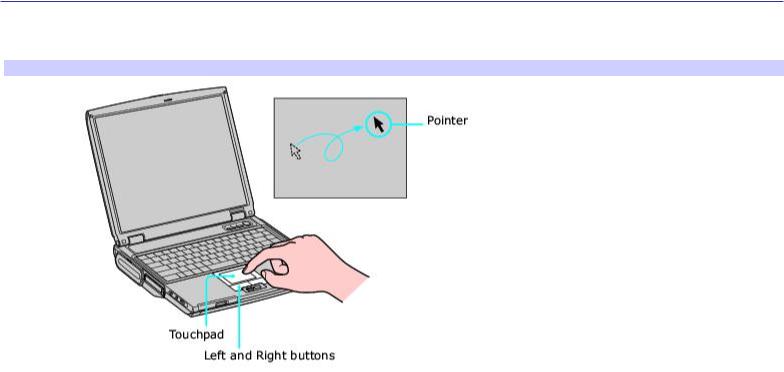
Using the Touchpad
The keyboard contains a cursor-pointing device called a touchpad. You can point to, select, drag, and scroll objects on the screen using the built-in touchpad.
Touchpad
Action |
Description |
|
Point |
Slide one finger on the touchpad to place the pointer on an item or object. |
|
Click |
Press the left button once. |
|
Double-click |
Press the left button twice. |
|
Right-click |
|
Press the right button once. In many applications, this action displays a shortcut menu of context-sensitive |
choices. |
|
|
Drag |
Slide one finger while pressing the left button. |
|
Scroll |
Move your finger along the right edge of the touchpad to scroll vertically. Move your finger along the bottom to |
|
scroll horizontally. (The scroll function is available only with applications that support a touchpad scroll feature.)
The Mouse Properties dialog box lets you customize your mouse and touchpad features, such as touch sensitivity, motion, and buttons.
To open the Mouse Properties dialog box
1.Click Start on the Windows® taskbar, and then Control Panel.
2.Click Printers and Other Hardware, and then Mouse. The Mouse Properties dialog box opens.
Page 10

VAIO Action Setup
VAIO Action Setup manages the settings for your computer's center Jog Dial Control, Memory Stick® media, and i.LINK®1 interface. An overview of some of the functions controlled by VAIO Action Setup is provided in this section. For more
information on changing the settings using VAIO Action Setup, right-click the Jog Dial Utility icon |
or |
in the taskbar and |
click Help Topics. |
|
|
1 i.LINK is a trademark of Sony used to designate that a product contains an IEEE 1394 connection. The i.LINK connection may vary, depending on the software applications, operating system, and compatible i.LINK devices. A ll products with an i.LINK connector may not communicate with each other. Refer to the documentation that came with your compatible i.LINK device for information on operating conditions and proper connection. Before connecting compatible i.LINK PC peripherals to your system, such as a C D-RW or hard disk drive, confirm their operating system compatibility and required operating conditions.
Page 11

Using the Center Jog Dial Control
Your computer is equipped with a center Jog Dial Control located below the left and right buttons. The center Jog Dial Control enables you to open an application, folder, or document from a predefined list by rotating and pressing the center Jog Dial Control. In addition, when you press the center Jog Dial Control, you can turn on your computer automatically and start the selected application or document.
Center Jog Dial Control
The center Jog Dial Control window always appears in the display. It is either in the launcher mode or in the guide mode.
Page 12
Using the center Jog Dial Control
This section explains how to use the center Jog Dial Control. For information on how to change the settings of the center Jog Dial Control, right-click the Jog Dial Utility icon  or
or  in the taskbar and click Help Topics.
in the taskbar and click Help Topics.
Page 13
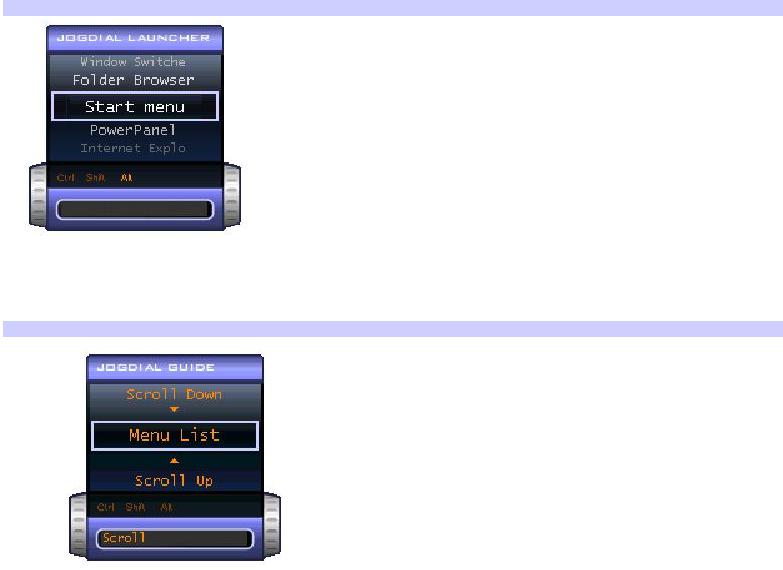
Launcher mode
The center Jog Dial Control window is in launcher mode until a software application is launched or the Jog Dial Control window becomes active. When you select an item in the Jog Dial Control window and it is displayed between orange bars, you can press the center Jog Dial Control to view a submenu of that item.
Using Launcher mode
To use the center Jog Dial Control, click the Jog Dial Control window or the Jog Dial Utility icon in the taskbar. Alternatively, you can press the center Jog Dial Control while the Jog Dial Control window is active to switch to launcher mode.
Jog Dial Launcher
To select a desired item, proceed as follows:
1.Rotate the center Jog Dial Control to select the item you want, and then press the center Jog Dial Control. The Jog Dial Launcher window switches to guide mode and shows the function of the center Jog Dial Control.
Jog Dial Guide
2.Rotate or press the center Jog Dial Control to use the desired function.
3.To select another item, repeat steps 1 through 3 above.
Page 14
Guide mode
The Jog Dial Control window is in the guide mode when software is in use and the software window is active. Depending on the software you are using, you can select items from the displayed list using the center Jog Dial Control. You can switch between guide mode and launcher mode by pressing the Ctrl key and the center Jog Dial Control.
Using Guide mode
The Jog Dial Control window displays the function of the center Jog Dial Control.
Page 15
Center Jog Dial back button
The center Jog Dial Control includes a back button located to the right of the control. Pressing this button brings you back to the previous screen.
Page 16
Using the center Jog Dial Control with Sony software
If Sony software that supports the center Jog Dial Control is active, you can use the functions of the center Jog Dial Control that are allocated to that software. For more information on functions allocated to software, see the software application's Help.
Page 17

Using the center Jog Dial Control with other software
If the software you are using supports the center Jog Dial Control, you can still use the center Jog Dial Control to scroll the window or adjust the window size.
Using a Dialog box
When a window such as Screen Properties is active, the Dialog box is displayed in the Jog Dial window. You can select an item in the window by rotating the center Jog Dial Control. Pressing the center Jog Dial Control is the equivalent of pressing Enter or Select.
Jog Dial Guide Dialog Box
Page 18

Using the Optical Disc Drive
Your computer comes with an optical disc drive, which is located on the right panel of the computer. See the Specifications sheet for the particular drive installed on your computer.
Page 19

To insert a disc
1.Turn on the computer.
 When the computer is in Standby or Hibernate mode, you cannot insert a disc. See Controlling Power Management for more information on Standby and Hibernate modes.
When the computer is in Standby or Hibernate mode, you cannot insert a disc. See Controlling Power Management for more information on Standby and Hibernate modes.
2.Press the Eject button to open the optical disc drive. The tray slides out.
Ejecting the Tray
 Avoid using adhesive labels to identify your discs. Adhesive labels may come off while the disc is in use in your optical disc drive, and may cause damage to the unit.
Avoid using adhesive labels to identify your discs. Adhesive labels may come off while the disc is in use in your optical disc drive, and may cause damage to the unit.
3.Place an optical disc on the tray with the label side facing up. For DVDs that can played on both sides, the side of the disc facing up is the side that plays.
4.Press the disc onto the hub until the disc clicks securely into place.
Inserting an Optical Disc
5.Close the tray by pushing it gently.
Page 20

To eject a disc
When you finish using a disc, wait until the LED indicator turns off, and then press the Eject button to remove the disc.
When the computer is in a power saving mode, you cannot remove an optical disc. See Controlling Power Management for more information about power saving modes.
If the optical disc does not slide out when you press the Eject button, turn off the computer and insert a thin, pointed object (such as a paper clip) into the manual eject hole.
 Make sure to seat the disc firmly over the hub fingers. If you do not seat the disc firmly, you could damage your optical disc drive and you may not be able to open the tray.
Make sure to seat the disc firmly over the hub fingers. If you do not seat the disc firmly, you could damage your optical disc drive and you may not be able to open the tray.
Manual Eject Hole
Page 21

To play a DVD
To play a DVD, you may use the optical disc drive and the preinstalled WinDVD® application. For more information, see the Help menu in the WinDVD application.
Before you use the optical disc drive to play a DVD, quit any open applications.
Your optical disc drive can read most DVD-R media. When you are ready to play a DVD, read the suggestions below to maximize your video viewing experience.
When playing a DVD on battery power, set the power management profile to DVD. You can also set the power management profile to Automatic Profile Selection if the display is not clear when using other profiles.
 Automatic Profile Selection sets the power management profile to DVD whenever a DVD is inserted. See "Controlling Power Management" for more information.
Automatic Profile Selection sets the power management profile to DVD whenever a DVD is inserted. See "Controlling Power Management" for more information.
If you connect your computer to a TV display, you may need to adjust the display resolution. Read the suggestions below to set the display resolution to the proper dimensions. Also see Selecting the Display Mode for more information.
If the computer is set to the default display setting, part of the video screen will not appear. To view the entire screen, adjust the display resolution to 1024 x 768.
 Some discs recorded at 20 or 24 bits may produce noise while playing. If you have audio devices connected, this may cause damage to your hearing and the speakers. Reduce the volume before playing a DVD.
Some discs recorded at 20 or 24 bits may produce noise while playing. If you have audio devices connected, this may cause damage to your hearing and the speakers. Reduce the volume before playing a DVD.
You cannot use the Fn + F8 function to switch between LCD and TV once a DVD is inserted into the optical disc drive.
Do not switch between LCD and the external display while the DVD is playing. This may cause a malfunction, and you may need to restart the DVD software.
Do not switch the power saving modes while you are playing the DVD.
Change the settings to disable the screen saver and the virus checker.
Do not use memory-resident utility software to speed up disc access. This may cause the computer to malfunction.
Page 22
To play an audio CD
To play an audio CD, make sure the audio function is turned on. To do this, complete the following procedure.
1.Click Start, and click Control Panel, and Performance and Maintenance, and System. The System Properties window appears.
2.Select the Hardware tab, and click Device Manager. The Device Manager window appears.
3.Double-click DVD/CD-ROM drives to open a list of the optical disc drive devices installed on your computer.
4.Right-click the particular optical disc drive device installed on your computer, and select Properties from the drop-down list. A properties window appears.
5.Select the Properties tab, and check the "Enable digital CD audio for this CD-ROM device" box, if it is not already checked.
6.Click OK.
Page 23
Notes on CD and DVD discs
Do not drop or bend the disc.
Do not touch the surface of the disc. Fingerprints and dust on the surface of a disc may cause reading errors. Proper care of the disc is essential to maintain its reliability. Do not use solvents such as benzine, thinner, commercially available cleaners or anti-static spray, as they may cause damage to the disc.
For normal cleaning, hold the disc by its edge and use a soft cloth to wipe the surface from the center out.
If the disc is badly soiled, moisten a soft cloth with water, wring it out well, and use it to wipe the surface of the disc from the center out. Wipe off any remaining moisture with a dry, soft cloth.
Page 24

To write data to a CD-RW or CD-R disc1
You can use Sony SonicStage and Microsoft® Windows® XP to write data to a CD-R or CD-RW disc. To create a CD-R disc that is readable in a CD-ROM drive, make sure that you finish the writing process before ejecting the disc. For more information, see the instructions included with Windows® XP.
Do not strike or shake the computer while writing data to a disc.
Always use the AC adapter as the power source for your computer if you are writing data to a CD-RW or CD-R disc. Using battery power may result in data transfer failure.
To avoid writing errors, remove the compact woofer or do not play music while writing data to a CD-RW or CD-R disc.
Notes on writing data to a CD-RW or CD-R disc
For optimal writing speed, deactivate the screen saver and exit anti-virus software before writing data to a disc.
For best results, use CD-Rs that are compatible with 16x speed.
Your computer does not support 1x or 2x writing speed.
Memory-resident disc utilities may cause unstable operation or data loss. Deactivate these utilities before writing data to a disc.
If your computer has preinstalled Microsoft® Office applications, such as Excel, Word, and Outlook, turn off the FindFast application.
1 For computer models equipped with a C D-RW/DV D C ombo Drive.
Page 25

Using PC Cards
Do not strike or shake the computer while writing data to a disc.
Always use the AC adapter as the power source for your computer if you are writing data to a CD-RW or CD-R disc. Using battery power may result in data transfer failure.
Your computer includes two PC Card slots. PC Cards enable you to connect portable external devices such as another hard disk drive, or a PC Network Interface Card (NIC) to connect to a network.
 The PC Card slots can accommodate two Type I/II PC Cards, or one Type III PC Card. These slots are compatible with CardBus. Use the lower slot for Type III PC Cards. You do not need to shut down your computer before inserting or removing a PC Card.
The PC Card slots can accommodate two Type I/II PC Cards, or one Type III PC Card. These slots are compatible with CardBus. Use the lower slot for Type III PC Cards. You do not need to shut down your computer before inserting or removing a PC Card.
Page 26
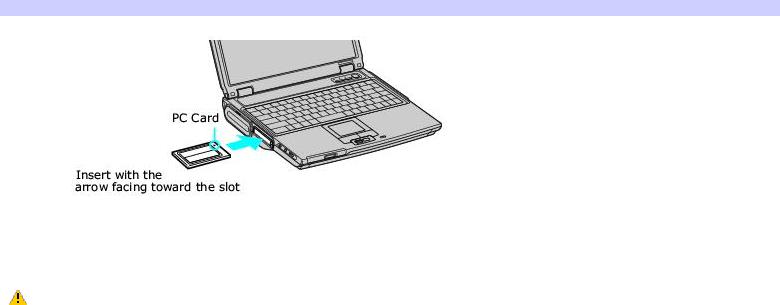
To insert a PC Card
1.Insert the PC Card into the PC Card slot. Make sure the front label of the PC Card is facing up.
Inserting a PC Card
2.Push the PC Card gently into the slot. The PC Card is automatically detected by your system. The  Unplug or Eject Hardware icon appears in the taskbar.
Unplug or Eject Hardware icon appears in the taskbar.
Do not force a PC Card into the slot as this may damage the connector pins.
Do not carry your computer while touching the head of a PC Card, as pressure or shock may damage the connector pins.
Page 27
To remove a PC Card
If your computer is turned on, follow these instructions. If your computer is turned off, skip to step number 5.
1.Close all applications that use the PC Card; otherwise, data may be lost.
2.Double-click the green arrow  icon in the taskbar.
icon in the taskbar.
3.Select an option in the Hardware devices box, and click Stop. The Stop a Hardware device window opens.
4.Click OK to confirm your selection, and then Close.
5.Press the PC Card Release button. The Release button pops out.
6.Press the PC Card Release button a second time (in some cases). Remove the card.
Notes on using PC Cards
For some PC Cards, if you alternate between normal power operation and the Standby or Hibernate power management modes while the card is inserted, you may find that a device connected to your system is not recognized. Restart your system to correct the problem.
Some PC Cards may require that you disable idle devices when using the PC Card. You can use Sony Notebook Setup to disable devices. See Displaying the Sony Notebook Setup Screen for more information.
Be sure to use the most recent software driver provided by the PC Card manufacturer.
If an exclamation mark (!) appears on the Device Manager tab in the System Properties dialog box, remove the software driver and then reinstall it.
You may not be able to use some PC Cards or some functions of the PC Card with this computer. If you have difficulty inserting a card, check that you are orienting the card correctly. See the manual that came with your PC Card for more information on its use.
Page 28

Using Memory Stick Media
This compact, portable, and versatile recording medium has a data capacity exceeding that of a floppy disk. The medium is specially designed for exchanging and sharing digital data with compatible products. Because it is removable, the media can be used for external data storage.
Page 29
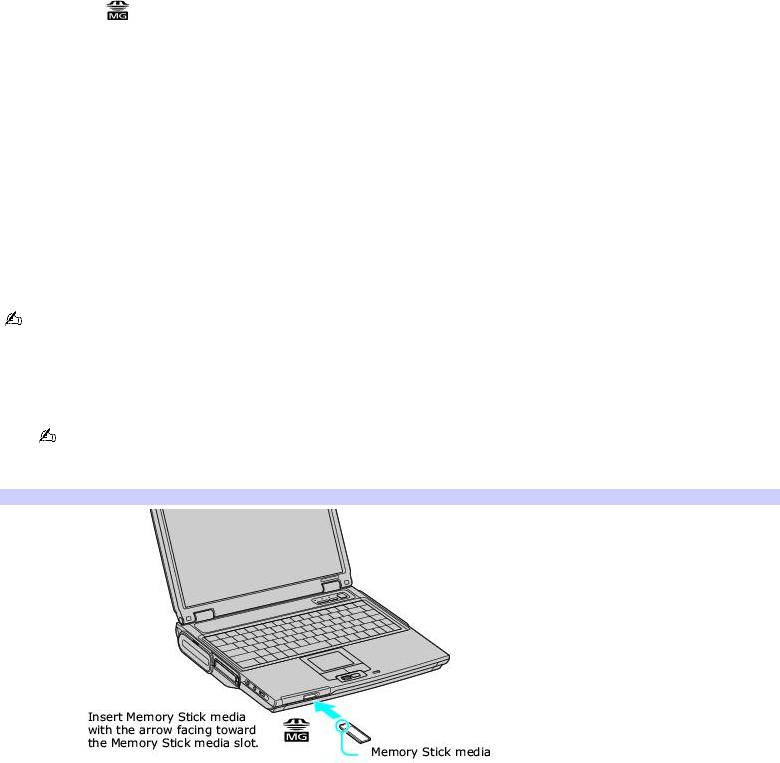
Types of Memory Stick media
The following two types of Memory Stick media can be used with your computer:
MagicGate 1 |
Memory Stick media (hereafter called MG Memory Stick media), which is provided with copyright |
protection |
|
Memory Stick2  media, which does not have the same copyright protection as MagicGate Memory Stick media
media, which does not have the same copyright protection as MagicGate Memory Stick media
Some music files with secure copyright protection may be stored on MG Memory Stick media but not on regular Memory Stick media.You can also use MagicGate media-compatible devices to record and playback music when they are connected to your computer.
You can store mixed data on the Memory Stick media. For example, you can copy an ordinary file onto a MG Memory Stick media that already contains music files.
What is MagicGate Memory Stick media?
MagicGate Memory Stick media provides copyright protection that consists of authentication and encryption technology. Authentication technology ensures that protected content is only transferred between compliant devices and media. Protected content is recorded and transferred in an encrypted format to prevent unauthorized duplication or playback.
MG Memory Stick media has the MG mark  .
.
To insert Memory Stick media
1.Insert the Memory Stick media with the arrow facing up and toward the Memory Stick media slot.
Inserting the media in the wrong direction may damage the connector pins.
2.Carefully slide the Memory Stick media into the slot until it clicks in place.
Inserting Memory Stick Media
To view the contents of Memory Stick media
1.Click Start in the Windows taskbar and then click My Computer
2.Double-click Sony Memory Stick under the Devices with Removable Storage box. The Sony Memory Stick window opens.
To remove Memory Stick media
1.Make sure the Memory Stick media indicator is off.
2.Push the Memory Stick media in toward the computer.
3.When the Memory Stick media ejects, pull it out.
Page 30
